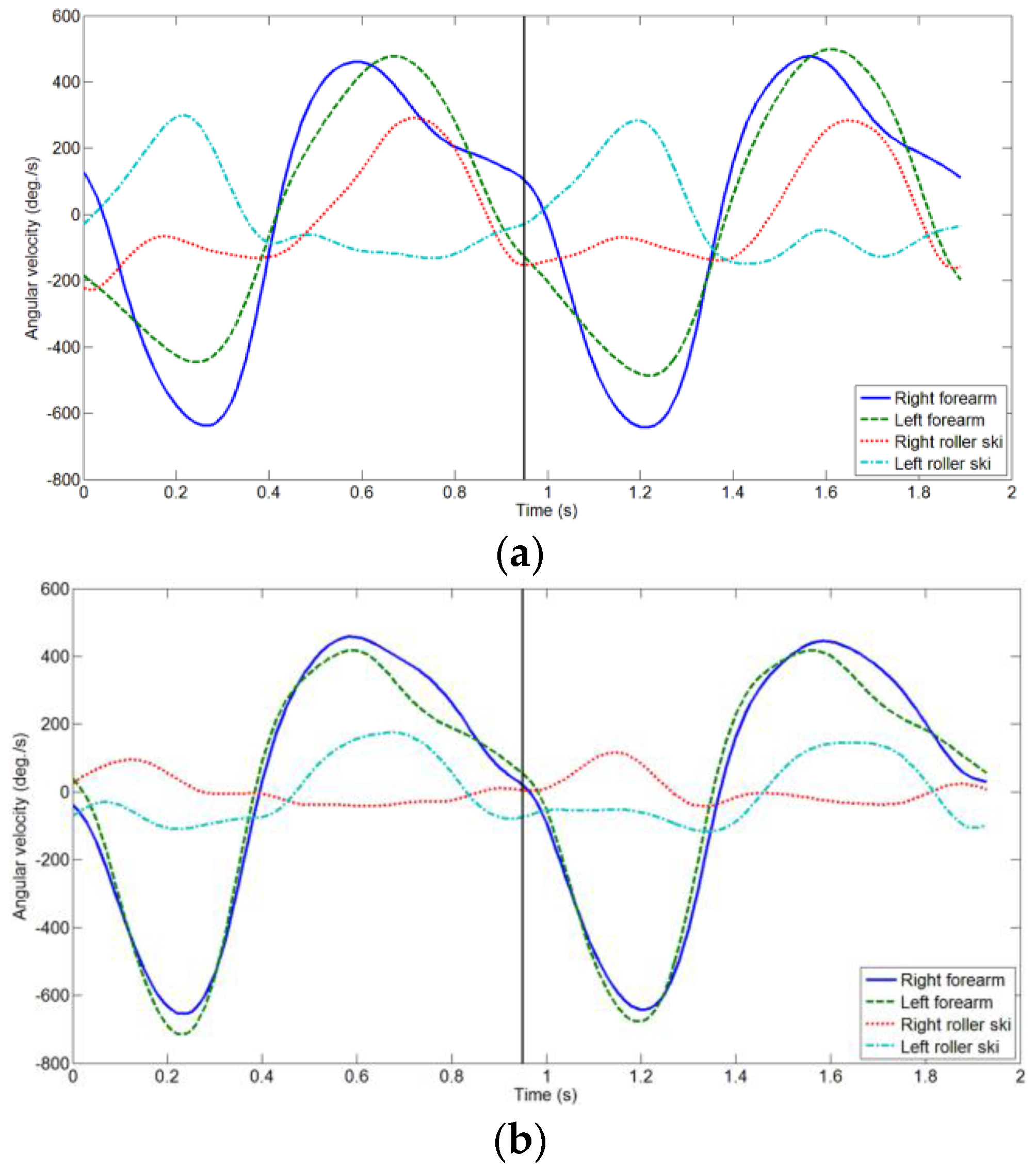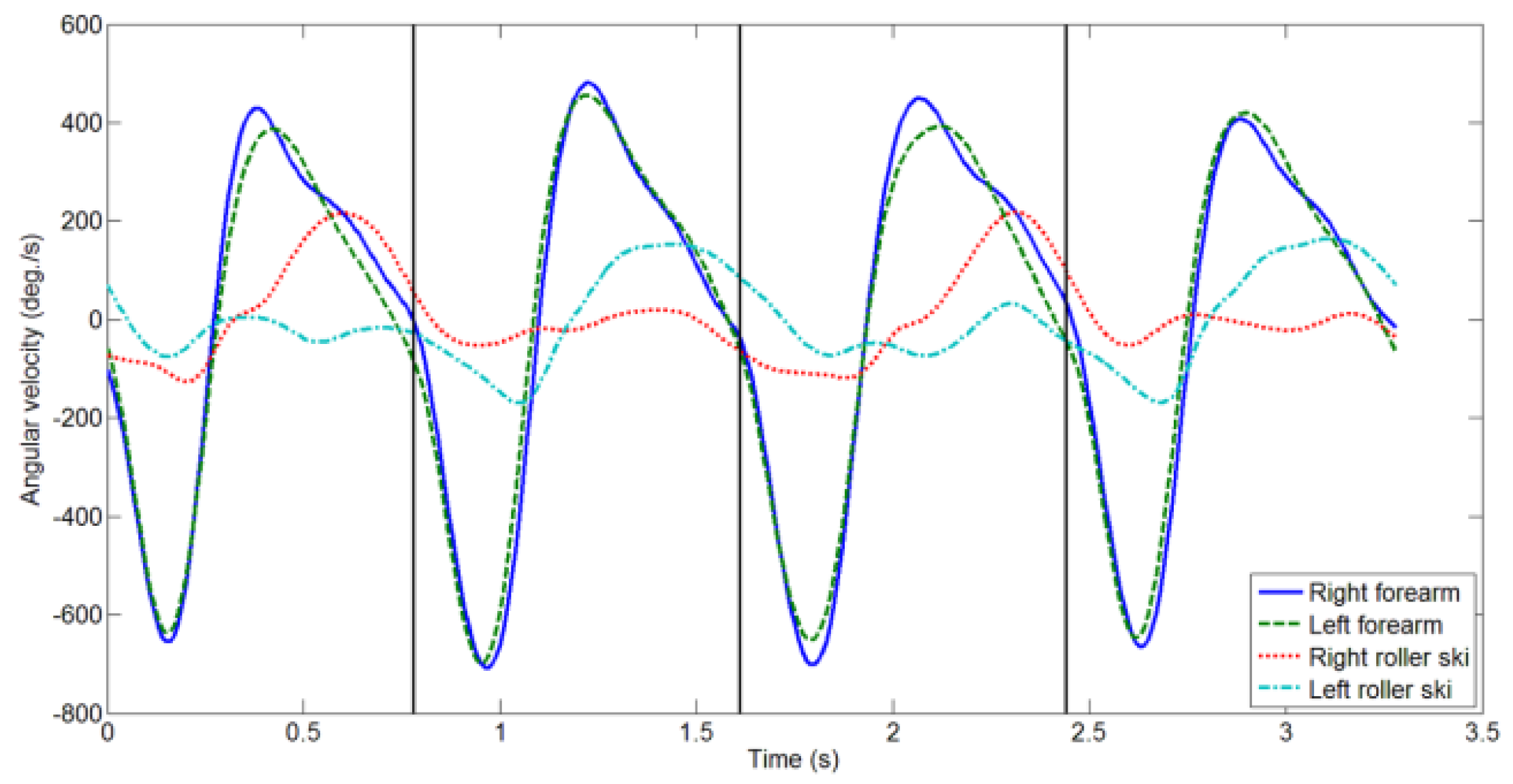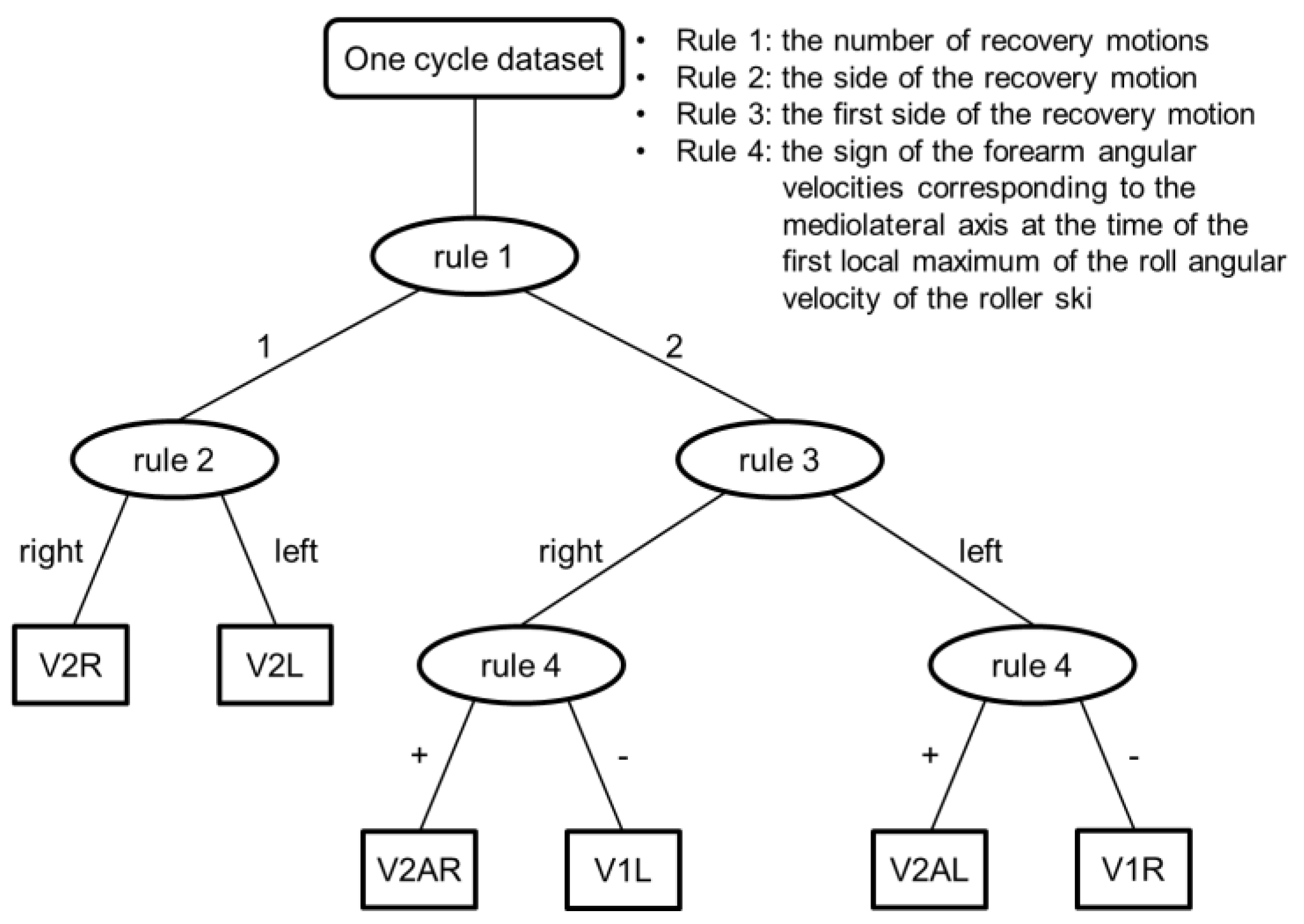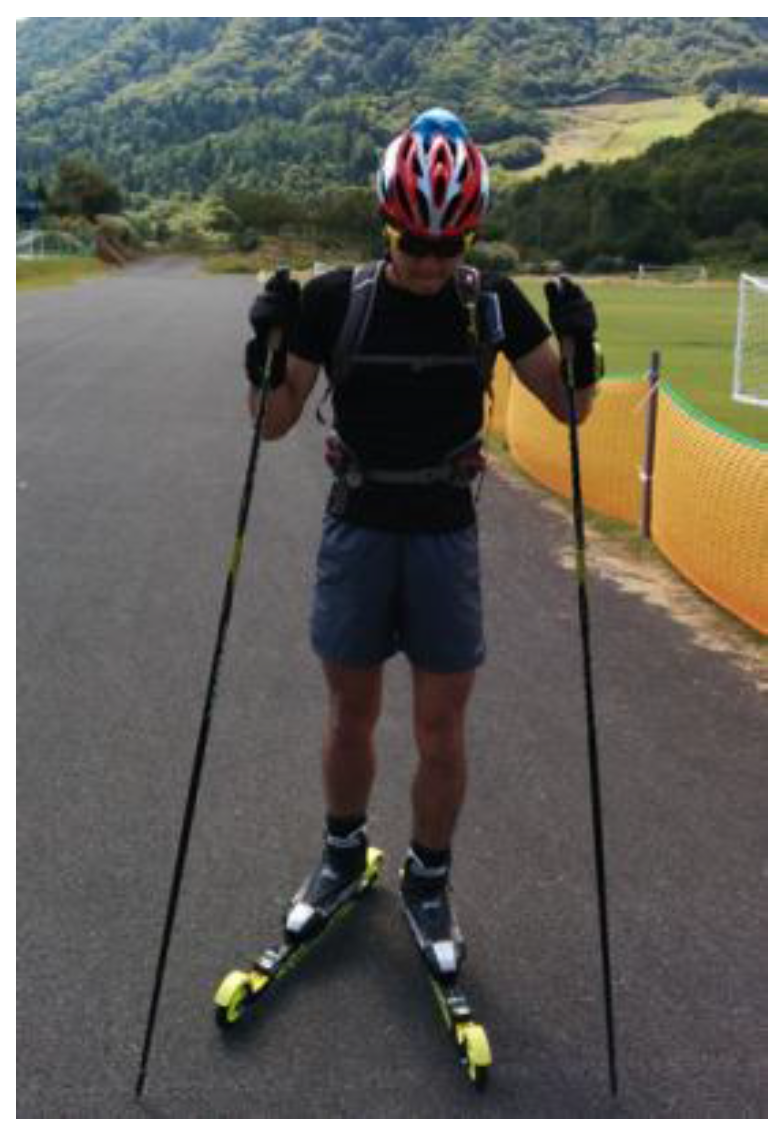Automatic Identification of Subtechniques in Skating-Style Roller Skiing Using Inertial Sensors
Abstract
:1. Introduction
2. Methods
2.1. Development of an Automated Identification System
2.1.1. Pre-Experiment
2.1.2. Definition of One Cycle
2.1.3. Definition of Recovery Motion
2.1.4. Detection of Main Subtechniques
2.1.5. Exceptions
2.2. Validation Experiment
2.2.1. Subjects
2.2.2. Protocol
2.2.3. Data Analysis
3. Results
4. Discussion
5. Conclusions
Acknowledgments
Author Contributions
Conflicts of Interest
References
- Nilsson, J.; Tveit, P.; Eikrehagen, O. Effects of speed on temporal patterns in classical style and freestyle cross-country skiing. Sports Biomech. 2004, 3, 85–108. [Google Scholar] [CrossRef] [PubMed]
- Millet, G.P.; Boissere, D.; Candau, R. Energy cost of different skating techniques in cross-country skiing. J. Sports Sci. 2003, 21, 3–11. [Google Scholar] [CrossRef] [PubMed]
- Bilodeau, B.; Roy, B.; Boulay, M.R. A comparison of three skating techniques and the diagonal stride on heart rate responses and speed in cross-country skiing. Int. J. Sports Med. 1991, 12, 71–76. [Google Scholar] [CrossRef] [PubMed]
- Kvamme, B.; Jakobsen, V.; Hetland, S.; Smith, G. Ski skating technique and physiological responses across slopes and speeds. Eur. J. Appl. Physiol. 2005, 95, 205–212. [Google Scholar] [CrossRef] [PubMed]
- Stöggl, T.; Kampel, W.; Müller, E.; Lindinger, S. Double-push skating versus V2 and V1 skating on uphill terrain in cross-country skiing. Med. Sci. Sports Exerc. 2010, 42, 187–196. [Google Scholar] [CrossRef] [PubMed]
- Bilodeau, B.; Boulay, M.R.; Roy, B. Propulsive and gliding phases in four cross-country skiing techniques. Med. Sci. Sports Exerc. 1992, 24, 917–925. [Google Scholar] [CrossRef] [PubMed]
- Andersson, E.; Supej, M.; Sandbakk, O.; Sperlich, B.; Stöggl, T.; Holmberg, H.C. Analysis of sprint cross-country skiing using a differential global navigation satellite system. Eur. J. Appl. Physiol. 2010, 110, 585–595. [Google Scholar] [CrossRef] [PubMed]
- Marsland, F.; Lyons, K.; Anson, J.; Waddington, G.; Macintosh, C.; Chapman, D. Identification of cross-country skiing movement patterns using micro-sensors. Sensors 2012, 12, 5047–5066. [Google Scholar] [CrossRef] [PubMed]
- Myklebust, H.; Losnegard, T.; Hallen, J. Differences in V1 and V2 ski skating techniques described by accelerometers. Scand. J. Med. Sci. Sports 2013, 24, 882–893. [Google Scholar] [CrossRef] [PubMed]
- Holst, A.; Jonasson, A. Classification of movement patterns in skiing. In Twelfth Scandinavian Conference on Artificial Intelligence: SCAI 2013; Jaeger, M., Lielsen, T.D., Viappiani, P., Eds.; IOS Press BV: Amsterdam, Holland, 2013; pp. 115–124. [Google Scholar]
- Stöggl, T.; Holst, A.; Jonasson, A.; Andersson, E.; Wunsch, T.; Norström, C.; Holmberg, H.C. Automatic classification of the sub-techniques (gears) used in cross-country ski skating employing a mobile phone. Sensors 2014, 14, 20589–20601. [Google Scholar] [CrossRef] [PubMed]
- Myklebust, H.; Nunes, N.; Hallén, J.; Gamboa, H. Morphological analysis of acceleration signals in cross-country skiing—Information extraction and technique transitions detection. In Proceedings of the Biosignals—International Conference on Bio-Inspired Systems and Singal Processing (BIOSTEC 2011), Rome, Italy, 26–29 January 2011.
- Fasel, B.; Favre, J.; Chardonnens, J.; Gremion, G.; Aminian, K. An inertial sensor-based system for spatio-temporal analysis in classic cross-country skiing diagonal technique. J. Biomech. 2015, 48, 3199–3205. [Google Scholar] [CrossRef] [PubMed]
- Sakurai, Y.; Fujita, Z.; Ishige, Y. Automated identification and evaluation of subtechniques in classical-style roller skiing. J. Sports Sci. Med. 2014, 13, 651–657. [Google Scholar] [PubMed]
- Bortolan, L.; Pellegrini, B.; Impellizzeri, F.; Schena, F.; Muller, E.; Lindinger, S.; Stöggl, T. Automatic detection of technique during on snow cross-country skiing. In Science and Skiing V; Muller, E., Lindinger, S., Stöggl, T., Eds.; Meyer & Meyer Sport: Tyrol, Austria, 2012; pp. 483–491. [Google Scholar]
- Sandbakk, S.B.; Supej, M.; Sandbakk, Ø.; Holmberg, H.C. Downhill turn techniques and associated physical characteristics in cross-country skiers. Scand. J. Med. Sci. Sports 2014, 24, 708–716. [Google Scholar] [CrossRef] [PubMed]
- Sandbakk, Ø.; Sandbakk, S.B.; Supej, M.; Holmberg, H.C. The velocity and energy profiles of elite cross-country skiers executing downhill turns with different radii. Int. J. Sports Physiol. Perform. 2014, 9, 41–47. [Google Scholar] [CrossRef] [PubMed]





| A | B | C |
|---|---|---|
| V1R | V1R | V1L, V2R, V2L, V2AR, V2AL |
| V1L | V1L | V1R, V2R, V2L, V2AR, V2AL |
| V2R | V2L, V2AL | V1R, V1L, V2R, V2AR |
| V2L | V2R, V2AR | V1R, V1L, V2L, V2AL |
| V2AR | V2L, V2AR | V1R, V1L, V2L, V2AL |
| V2AL | V2R, V2AL | V1R, V1L, V2R, V2AR |
| Cross-Country | Nordic Combined | ||
|---|---|---|---|
| Male (n = 4) | Female (n = 7) | Male (n = 4) | |
| Age (years) | 19.0 (2.0) | 20.1 (1.5) | 19.5 (1.3) |
| Height (m) | 1.78 (0.02) | 1.60 (0.05) | 1.72 (0.02) |
| Weight (kg) | 71.2 (2.6) | 52.7 (3.4) | 64.3 (2.7) |
| VO2max (mL/min/kg) | 69.9 (1.7) | 57.3 (6.1) | 63.3 (3.7) |
| Automatic Identification | ||||||||||
|---|---|---|---|---|---|---|---|---|---|---|
| V1R | V1L | V2R | V2L | V2AR | V2AL | V4 | Total | Accuracy (%) | ||
| Visual check | V1R | 120 | 1 | 1 | 0 | 3 | 0 | 2 | 127 | 94.5 |
| V1L | 0 | 40 | 0 | 0 | 0 | 0 | 1 | 41 | 97.6 | |
| V2R | 0 | 0 | 1920 | 1 | 0 | 7 | 20 | 1950 | 98.5 | |
| V2L | 0 | 0 | 0 | 1932 | 3 | 0 | 20 | 1955 | 98.8 | |
| V2AR | 0 | 0 | 7 | 0 | 767 | 0 | 31 | 805 | 95.3 | |
| V2AL | 0 | 0 | 3 | 15 | 1 | 587 | 21 | 631 | 93.0 | |
| V4 | 17 | 5 | 39 | 27 | 59 | 44 | 1047 | 1259 | 83.2 | |
| Total | 137 | 46 | 1970 | 1975 | 833 | 638 | 1142 | |||
| Precision (%) | 87.6 | 87.0 | 97.5 | 97.8 | 92.1 | 92.0 | 91.7 | |||
© 2016 by the authors; licensee MDPI, Basel, Switzerland. This article is an open access article distributed under the terms and conditions of the Creative Commons by Attribution (CC-BY) license (http://creativecommons.org/licenses/by/4.0/).
Share and Cite
Sakurai, Y.; Fujita, Z.; Ishige, Y. Automatic Identification of Subtechniques in Skating-Style Roller Skiing Using Inertial Sensors. Sensors 2016, 16, 473. https://doi.org/10.3390/s16040473
Sakurai Y, Fujita Z, Ishige Y. Automatic Identification of Subtechniques in Skating-Style Roller Skiing Using Inertial Sensors. Sensors. 2016; 16(4):473. https://doi.org/10.3390/s16040473
Chicago/Turabian StyleSakurai, Yoshihisa, Zenya Fujita, and Yusuke Ishige. 2016. "Automatic Identification of Subtechniques in Skating-Style Roller Skiing Using Inertial Sensors" Sensors 16, no. 4: 473. https://doi.org/10.3390/s16040473
APA StyleSakurai, Y., Fujita, Z., & Ishige, Y. (2016). Automatic Identification of Subtechniques in Skating-Style Roller Skiing Using Inertial Sensors. Sensors, 16(4), 473. https://doi.org/10.3390/s16040473





